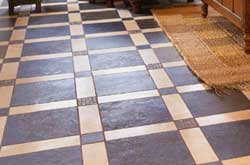Laminate Flooring: Hardwood's Killer or Colleague?
See if We Have Top-Rated
Flooring Professionals in Your Area

Since laminate flooring emerged on the scene, it has enjoyed remarkable growth with a 40 percent annual growth rate for much of the 1990s. The turn of the century has been particularly kind to laminate flooring as demand surpassed wood flooring some time in the first half of the new decade. At the same time, forecasts from the market research group Freedonia suggest the demand for laminate flooring may double the demand for wood flooring during the middle of the next decade. These trends have real estate agents, remodeling/flooring contractors, and homeowners all wondering if laminate flooring could replace hardwood flooring or if laminate will reach a natural market saturation.
Reasons for Laminate Flooring's Rise
The biggest reason has to be cost. Some sources claim hardwood flooring can cost as much as two to three times as much as laminate. HomeAdvisor—leading online resource connecting homeowners with home improvement contractors—sees much closer numbers. The average wood flooring installation costs $5,106, while new laminate flooring averages $3,899. Hardwood floors are generally a more coveted material for home-buyers, but the idea that relative to its installation cost hardwood returns a greater percentage of its value is a dubious claim at best. In truth, the condition of either laminate or hardwood flooring is far more important, and as laminate's reputation continues to gain momentum, more and more home-buyers are as likely to covet laminate's low-maintenance as hardwood's traditional appeal.
As a corollary to its cost, the ease of installation is a huge selling point for laminate flooring manufacturers and homeowners. Anyone with basic carpentry skills and a weekend to devote to the job can install a basic laminate flooring system, although if you're considering a high-quality laminate or dynamic design features like borders, insets, and color variations, it's probably best to leave the job to the professionals. The total cost is still likely to come in under the cost of hardwood.
After Laminate Flooring, what's the Case for Hardwood Floors?
It's important to note that the escalating demand for laminate flooring includes the non-residential market, an arena that has never been a strong suit for hardwood. Cost-effective, easier to clean, and hypoallergenic, laminate flooring performs especially strong in the commercial sector and institutional buildings—such as educational, health care, and religious facilities. Thus, hardwood flooring probably has a bigger niche to fill in the residential market than a cursory analysis of the flooring market suggests, but hardwood is facing an enduring onslaught from laminate and other hard-surface flooring options. The case for hardwood flooring used to revolve around the untested nature of laminate and the resale value of this premium material. Today, the case for hardwood flooring is more likely to rest on homeowners' preference, pride, and willingness to preserve the beauty of a real wood floor.
Shared Strengths: Six of One, Half a Dozen of the Other
1. Versatility and Availability of Design: Laminate has the advantage of greater reliability—what you see is what you get, although certain lines of laminate flooring may go out of production, meaning you should always buy extra planks upfront. On the other hand, the authenticity and imperfections of natural wood guarantees a one-of-a-kind floor that appeals to many homeowners. Availability and versatility is virtually unlimited for either material with any color, grain, or style readily purchased.
2. Maintenance and Durability:
3. Eco-Friendly Flooring:
Former King of Flooring Destined for Niche Status
Maintenance and durability should really be seen as a continuum for these flooring products. Hardwood flooring can last for 100 years or more—if it's properly maintained. It's unlikely laminate will hang around this long, although the average lifespan of high-quality laminate flooring may outperform hardwood flooring given that it requires even less maintenance and long-term attention. At the same time, laminate flooring is more likely to suffer from the blunt force of furniture and feet, although as long as you have extra planks, repairs can be a relatively simple task.
Depending on the species and source of your wood flooring and the manufacturing process of laminate flooring, either type can be labeled as better or worse for the environment. Neither are great, but nor are they villainous. Plus, neither material can claim superiority over truly eco-friendly flooring like bamboo and cork.
According to Freedonia, the hard-surface flooring market is expected to grow 3.9 percent per annum through 2011, as the growth of hardwood flooring decelerates and potentially levels off altogether. It's unlikely that laminate flooring will ever completely finish off the market for hardwood flooring, but each year the trends lines continue to support the notion that hardwood, one of the former kings of the flooring industry, is destined for niche status.

